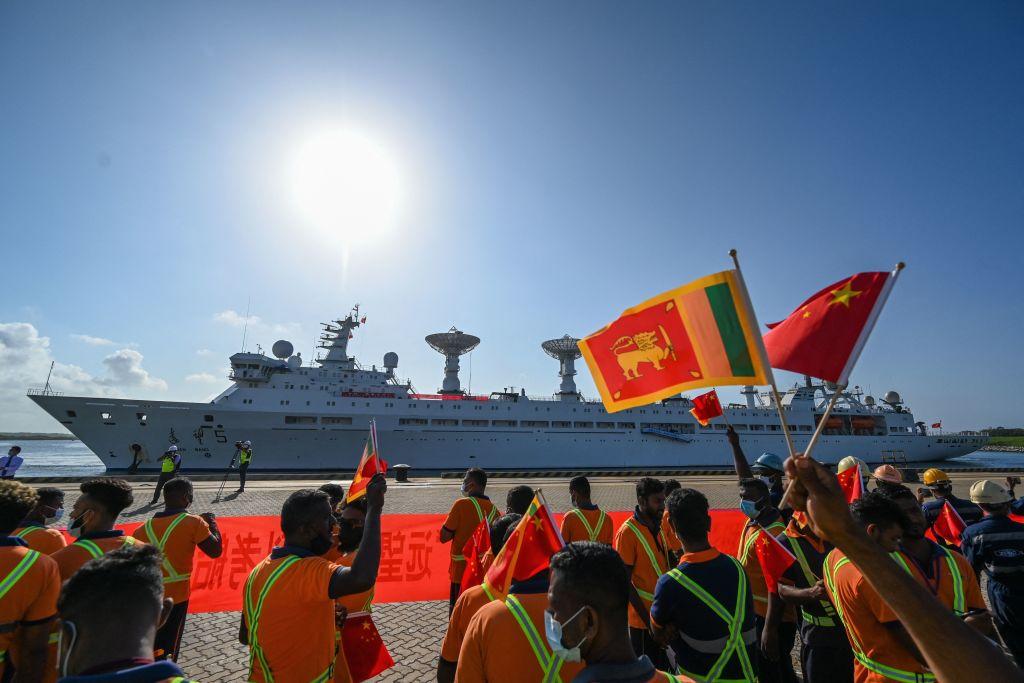
In September 2014, Sri Lanka stirred the embers of conflict in the Indian Ocean region by allowing Chinese naval vessels to dock at one of its ports.
At the time, India took issue with the visit, citing a 1987 accord with Sri Lanka that precluded the two countries from engaging in activities prejudicial to one another’s security. Sri Lanka’s navy dispelled India’s anxiety by underscoring the visit’s normality. The port call was ‘nothing unusual’, one Sri Lankan military official said; 230 other warships had pulled into Colombo since 2010.
Five years on, Sri Lanka’s ports have further ignited Sino-Indian maritime competition in the region. On 16 August, a Chinese ballistic missile and satellite tracking and survey ship, Yuan Wang 5, called at Sri Lanka’s Hambantota port for a five-day replenishment. Sri Lankan military officials brushed off insinuations that the visit signalled their cosying up to China. The visit was approved based on ‘standard procedure’, they said. But nothing about the Yuan Wang 5 visit was standard—not even the procedure.
In late July, Colombo originally greenlighted the Yuan Wang 5 visit from August 11 to 17, expecting minimal blowback. But much has changed since 2014. China is now a great naval power that has achieved ‘near seas’ control and is shoring up its ‘far seas’ efforts. China finished building Hambantota port in 2017 and then gained control of it in 2018 when Sri Lanka couldn’t repay Chinese loans. Sri Lanka is vulnerable to China—its largest creditor—after defaulting on its debt earlier this year.
Recognising this strategic shift, New Delhi and Washington raised concerns with Colombo about the visit. They feared China would offer debt relief in exchange for turning Hambantota port into a Chinese naval base (known as ‘debt-trap diplomacy’) and that the Yuan Wang 5’s three long-range satellite dishes could ‘spy’ on Indian defence installations or missile launches.
Sri Lanka waffled under international pressure, asking China to defer the visit ‘until further consultations’. China warned Sri Lanka that scuttling the visit would affect future debt and trade deals. In the end, Sri Lanka tried pleasing everyone. The Yuan Wang 5 could visit, as long as it turned off its intelligence collection and turned on its automatic identification system when operating in Sri Lankan waters.
The ship’s visit exemplified the growing Sino-Indian maritime competition and China’s blueprint for familiarising itself with, normalising its presence in, and testing the limits of its influence in the Indian Ocean region.
China’s Indian Ocean strategy is based on the ‘Malaccan dilemma’, a term coined by President Hu Jintao in 2003 to describe China’s undue reliance on trade routes that pass through the Malacca Straits. Hu feared that other countries (that is, the US and India) could strangle China in a conflict through blockades and ‘commerce-raiding’.
Hu’s anxiety was half right. China’s vital economic interests are tied up in this choke point. An estimated 40% of Chinese trade flows through the Malacca Strait. But blockade anxiety is a bit far-fetched. No one wins a conflict designed to disrupt critical sea lines of communications, especially trade kingpins like the US and India. Despite this unfounded fear, China remains concerned—and it shows.
Tell-tale signs include China’s increased access to military bases in Djibouti, the Seychelles and Oman, and its port development projects in Cambodia, Sri Lanka, Pakistan and Bangladesh. Since 2008, the Chinese navy has also deployed more than 40 naval escort taskforces to the Gulf of Aden to fight piracy. But piracy in the Horn of Africa has dissipated since 2016. So why is China still sending these taskforces?
The tyranny of distance and size precludes Chinese ‘far seas’ control in the Indian Ocean region. But China doesn’t need control to allay its fears, just deterrence. Expeditionary deployments, ‘far seas’ operations and foreign military access enable China to refine its blue-water proficiency, normalise its presence in the region and establish partnerships with smaller nations that can join China’s network of naval resupply outposts. These efforts can then provide ‘reliable security support’ for China’s overseas interests, prevent foreign ‘far seas’ interference, and even threaten another country’s trade in wartime.
The Yuan Wang 5 visit was not only a catalyst, but also a microcosm of this competition as Beijing and New Delhi vie for influence and leverage in Sri Lanka. China has lent Sri Lanka more than US$12 billion for infrastructure investments, which makes up nearly 20% of Sri Lanka’s foreign debt. Ending Sri Lanka’s economic crisis also depends on restructuring Chinese debt. When Sri Lanka defaulted on its debt earlier this year—and China refused to provide more aid—India filled the void with US$4 billion in loans for fuel and food. A day before the Yuan Wang 5 arrived, India also fortuitously gifted a Dornier maritime patrol aircraft to Sri Lanka.
Sri Lankan President Ranil Wickremesinghe believes his country has ‘kept out of the power rivalry’ in the region but will soon find it ‘more difficult to maintain a balance’. If China demands more port calls and military access at Sri Lanka, Colombo will have no option but accommodation. China’s debt is a ‘noose around our neck’, says one former Sri Lankan diplomat.
Without resorting to predatory economic practices, India can still out-influence China in Sri Lanka and the Indian Ocean region. It starts with the Quad alliance giving India the resources to develop or procure reconnaissance platforms to improve its maritime domain awareness, more small warships to match China ship for ship, and cheaper (but effective) asymmetric weapons. It also includes providing viable alternatives to China’s regional infrastructure projects, port visits and access arrangements.
If India can’t counter China short of war, the Indian Ocean region will devolve (at best) into arms races and territorial incursions while smaller nations caught in the crosshairs (like Sri Lanka) become battlefields of influence. That should be avoided. To quote the African proverb: ‘When elephants fight, it is the grass that suffers.’